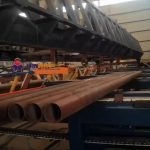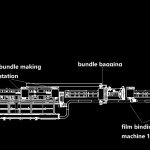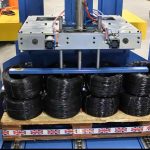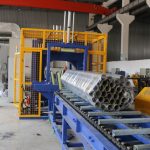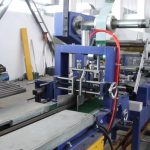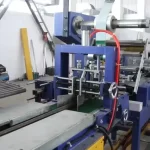Feature Comparison: Budget-Friendly vs. High-End PU/PE Tube Packing Systems
In the world of industrial packaging, the choice between budget-friendly and high-end PU/PE tube packing systems can significantly impact your production efficiency, product quality, and bottom line. This comprehensive guide will delve into the intricacies of both options, helping you make an informed decision that aligns with your business needs and financial constraints. Let’s explore the features, benefits, and potential drawbacks of each category to determine which system might be the best fit for your operation.
Understanding PU/PE Tube Packing Systems
Before we dive into the comparison, it’s crucial to understand what PU/PE tube packing systems are and why they’re essential in various industries. These systems are designed to package polyurethane (PU) or polyethylene (PE) tubes efficiently, protecting them during storage and transportation. Industries such as automotive, construction, and manufacturing heavily rely on these systems to ensure their products reach customers in pristine condition.
Key Components of Tube Packing Systems
Regardless of whether you opt for a budget-friendly or high-end system, most PU/PE tube packing machines consist of the following core components:
- Feeding mechanism
- Cutting unit
- Sealing system
- Conveyor belt
- Control panel
The quality, precision, and sophistication of these components often differentiate budget-friendly systems from their high-end counterparts.
Budget-Friendly PU/PE Tube Packing Systems: An Overview
Budget-friendly options are designed to provide essential packing functionality without breaking the bank. These systems are often favored by small to medium-sized businesses or those just starting in the industry.
Advantages of Budget-Friendly Systems
- Cost-effective: The primary advantage is the lower initial investment required.
- Simplicity: These systems often have straightforward designs, making them easier to operate and maintain.
- Compact size: Many budget options have a smaller footprint, ideal for facilities with limited space.
- Adequate for basic needs: For businesses with lower production volumes or simpler packaging requirements, these systems can be sufficient.
Potential Limitations
- Lower speed: Budget systems typically have slower packing rates compared to high-end alternatives.
- Limited customization: You may have fewer options for adjusting settings to meet specific packaging needs.
- Durability concerns: Some budget systems may use lower-quality materials, potentially leading to more frequent repairs or replacements.
High-End PU/PE Tube Packing Systems: Exploring Advanced Features
High-end systems represent the cutting edge of tube packing technology. They often incorporate advanced features and superior build quality to meet the demands of high-volume production environments.
Advantages of High-End Systems
- Superior speed and efficiency: These systems can significantly boost production rates.
- Advanced customization options: High-end machines often offer more precise control over packing parameters.
- Enhanced durability: Built with premium materials, these systems are designed for longevity and consistent performance.
- Automation capabilities: Many high-end systems integrate seamlessly with other automated production processes.
Potential Drawbacks
- Higher initial cost: The advanced features and superior build quality come at a premium.
- Complexity: Some high-end systems may require specialized training for operation and maintenance.
- Overkill for small operations: Smaller businesses may not fully utilize the capabilities of a high-end system.
Comparing Feeding Mechanisms
The feeding mechanism is crucial in determining the overall efficiency of a PU/PE tube packing system. Let’s examine how this component differs between budget-friendly and high-end options.
Budget-Friendly Feeding Mechanisms
- Manual or semi-automatic feeding: Many budget systems require some level of manual intervention.
- Basic sensors: Lower-end machines might use simpler sensors for tube detection and alignment.
- Limited size range: Budget options may have restrictions on the diameter or length of tubes they can handle.
High-End Feeding Mechanisms
- Fully automated feeding: High-end systems often feature advanced automatic feeding systems.
- Precision sensors: These machines use sophisticated sensors for accurate tube positioning.
- Versatile size handling: Many premium systems can accommodate a wider range of tube sizes without adjustment.
Cutting Unit Comparison
The cutting unit’s precision and speed significantly impact the quality of the final packaged product. Here’s how budget and high-end systems differ in this aspect.
Budget-Friendly Cutting Units
- Basic blade designs: Often use simpler blade configurations.
- Manual adjustments: May require manual adjustment for different tube sizes.
- Adequate for standard materials: Perform well with common PU/PE tube materials.
High-End Cutting Units
- Advanced cutting technology: May incorporate laser or ultrasonic cutting for superior precision.
- Automatic adjustments: Often feature systems that automatically adjust to different tube specifications.
- Versatility: Can handle a wider range of materials, including specialty or difficult-to-cut tubes.
Sealing System Analysis
The sealing system ensures that packaged tubes remain protected during storage and transportation. Let’s explore the differences in sealing technology between budget and high-end options.
Budget-Friendly Sealing Systems
- Basic heat sealing: Typically use straightforward heat sealing mechanisms.
- Manual temperature control: May require manual adjustment of sealing temperature.
- Standard seal patterns: Often limited to basic seal designs.
High-End Sealing Systems
- Advanced sealing technologies: May incorporate ultrasonic or impulse sealing for superior results.
- Precise temperature control: Often feature automatic temperature regulation for consistent seals.
- Customizable seal patterns: Many high-end systems allow for unique or brand-specific seal designs.
Conveyor Systems: Budget vs. High-End
The conveyor system plays a crucial role in the overall efficiency of the packing process. Here’s how they compare across different price points.
Budget-Friendly Conveyor Systems
- Basic belt materials: Often use standard conveyor belt materials.
- Fixed speeds: May have limited or no speed adjustment capabilities.
- Manual tracking: Might require manual adjustment to ensure proper belt tracking.
High-End Conveyor Systems
- Premium belt materials: Use high-quality, durable conveyor belts designed for longevity.
- Variable speed control: Often feature adjustable speeds to match production requirements.
- Automatic tracking: Many include systems for automatic belt alignment and tracking.
Control Panel and User Interface Comparison
The control panel is the nerve center of any PU/PE tube packing system. The sophistication of this component can greatly affect ease of use and overall efficiency.
Budget-Friendly Control Panels
- Basic interfaces: Often feature simple button or touchpad controls.
- Limited data display: May provide only essential information on machine status.
- Manual parameter input: Usually require manual input of packing parameters.
High-End Control Panels
- Advanced touchscreen interfaces: Often feature large, intuitive touchscreen displays.
- Comprehensive data visualization: Provide detailed real-time data on all aspects of the packing process.
- Recipe storage: Allow for storage and quick recall of multiple packing parameter sets.
Energy Efficiency: A Growing Concern
As energy costs rise and environmental concerns grow, the energy efficiency of packing systems becomes increasingly important. Let’s examine how budget and high-end systems compare in this aspect.
Budget-Friendly Systems and Energy Use
- Standard motors: Often use conventional motors without advanced energy-saving features.
- Basic power management: May lack sophisticated power-saving modes.
- Limited efficiency data: Might not provide detailed information on energy consumption.
High-End Systems and Energy Efficiency
- Energy-efficient components: Often incorporate energy-saving motors and other efficient components.
- Advanced power management: Many feature intelligent systems that optimize power use based on production demands.
- Detailed energy monitoring: Frequently provide comprehensive data on energy consumption for better resource management.
Maintenance and Longevity Considerations
The long-term costs associated with maintenance and system longevity can significantly impact the total cost of ownership. Here’s how budget and high-end systems differ in this aspect.
Budget-Friendly System Maintenance
- More frequent maintenance: May require more regular servicing due to wear and tear.
- Basic wear parts: Often use standard components that may need more frequent replacement.
- Limited self-diagnostics: Might lack advanced systems for identifying potential issues before they cause downtime.
High-End System Maintenance
- Extended service intervals: Premium components often allow for longer periods between required maintenance.
- Durable wear parts: Use high-quality materials that extend the life of critical components.
- Advanced diagnostics: Many feature sophisticated self-diagnostic systems that can predict and prevent potential failures.
Integration Capabilities: Connecting Your Packing System
In today’s interconnected manufacturing environments, the ability of a packing system to integrate with other production processes can be crucial. Let’s explore how budget and high-end systems compare in this aspect.
Budget-Friendly Integration Options
- Basic connectivity: May offer limited options for connecting to other systems.
- Manual data transfer: Might require manual input of production data into other systems.
- Limited customization: Often have restricted ability to adapt to unique production workflows.
High-End Integration Capabilities
- Advanced connectivity: Often feature multiple options for connecting to other production systems.
- Automated data sharing: Many can automatically share production data with ERP or MES systems.
- Customizable workflows: Frequently offer the flexibility to adapt to specific production requirements.
The Impact of Industry 4.0 on PU/PE Tube Packing Systems
The concept of Industry 4.0, or the Fourth Industrial Revolution, is reshaping manufacturing processes worldwide. Let’s examine how this trend affects budget and high-end packing systems.
Budget-Friendly Systems in the Industry 4.0 Era
- Limited smart features: May lack advanced sensors or IoT connectivity.
- Basic data collection: Might offer only rudimentary production data gathering capabilities.
- Manual updates: Often require manual software or firmware updates.
High-End Systems Embracing Industry 4.0
- IoT integration: Many feature built-in Internet of Things (IoT) capabilities for real-time monitoring and control.
- Advanced analytics: Often provide sophisticated data analysis tools for optimizing production.
- Remote management: Frequently allow for remote monitoring, control, and troubleshooting.
Conclusion: Choosing the Right PU/PE Tube Packing System for Your Needs
When it comes to selecting between budget-friendly and high-end PU/PE tube packing systems, there’s no one-size-fits-all solution. The right choice depends on a variety of factors including your production volume, budget constraints, specific packaging requirements, and long-term business goals.
Budget-friendly systems offer a cost-effective entry point for smaller operations or those with simpler packaging needs. They provide essential functionality without the high initial investment of premium systems. However, they may have limitations in terms of speed, customization, and advanced features.
High-end systems, while more expensive upfront, offer superior performance, durability, and advanced features that can significantly boost productivity and reduce long-term costs. They’re particularly well-suited for high-volume operations or those requiring precise control over packaging parameters.
Ultimately, the decision should be based on a careful analysis of your current needs and future growth projections. Consider factors such as production volume, required packaging precision, energy efficiency, maintenance costs, and integration requirements. It may be helpful to conduct a total cost of ownership analysis, factoring in not just the initial purchase price, but also ongoing operational costs and potential productivity gains.
Remember, the most expensive option isn’t always the best fit, nor is the cheapest always the most cost-effective in the long run. By thoroughly understanding the features and limitations of both budget-friendly and high-end PU/PE tube packing systems, you can make an informed decision that aligns with your business objectives and sets you up for success in the competitive world of industrial packaging.
